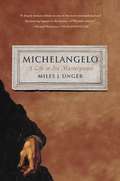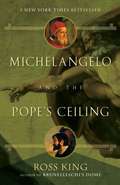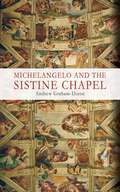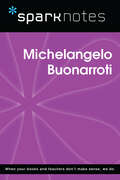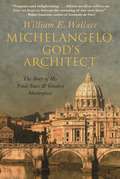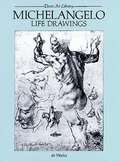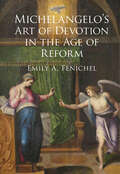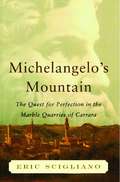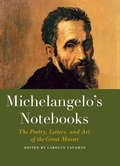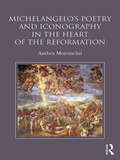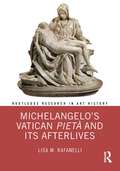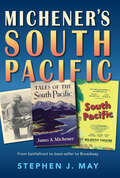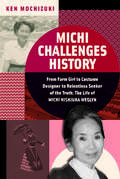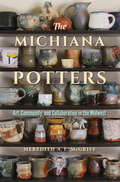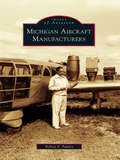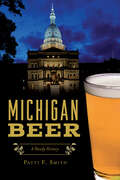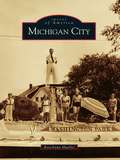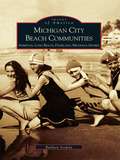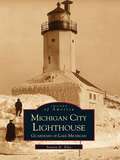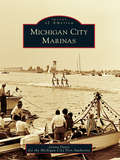- Table View
- List View
Michelangelo: A Study In The Nature Of Art (Routledge Classics)
by Adrian StokesAdrian Stokes was one of the twentieth century's finest and most discriminating writers on art. Of over twenty works of art criticism, Michelangelo was considered by Lawrence Gowing to be the most complete he ever wrote, presenting an understanding of the great artist that no one subsequently could afford to ignore. Stokes brings to bear in this work not only twenty-five years' study and appreciation of Italian Renaissance art and of aesthetics, but also a unique psychological perspective, as he explains in his introduction, which enables him to uncover the depths of the artist's personality. The subtlety of feeling and profound knowledge of sculpture which Sir Herbert Read admired in Stokes's work is also combined with a literary style perfected through his own poetry and criticism. Presenting a unique survey of his subject's literary as well as his artistic legacy, Stokes succeeds, as no other has before or since, in his aim of bringing Michelangelo's greatness into nearer view.
Michelangelo: A Life in Six Masterpieces
by Miles J. UngerThis is the life of one of the most revolutionary artists in history, told through the story of six of his greatest masterpieces: “The one indispensable guide for encountering Michelangelo on his home turf” (The Dallas Morning News).Michelangelo stands alone as a master of painting, sculpture, and architecture, a man who reinvented the practice of art itself. Throughout his long career he clashed with patrons by insisting that he had no master but his own demanding muse. Michelangelo was ambitious, egotistical, and difficult, but through the towering force of genius and through sheer pugnaciousness, he transformed the way we think about art. Miles Unger narrates the life of this tormented genius through six of his greatest masterpieces. Each work expanded the expressive range of the medium, from the Pietà carved by a brash young man of twenty-four, to the apocalyptic Last Judgment, the work of an old man weighed down by the unimaginable suffering he had witnessed. In the gargantuan David he depicts Man in the glory of his youth, while in the tombs he carved for his Medici overlords he offers perhaps history’s most sustained meditation on death and the afterlife of the soul. In the vast expanse of the Sistine Chapel ceiling he tells the epic story of Creation. During the final decades of his life, his hands too unsteady to wield the brush and chisel, he exercised his mind by raising the soaring vaults and dome of St. Peter’s in a final tribute to his God. “A deeply human tribute to one of the most accomplished and fascinating figures inthe history of Western culture” (The Boston Globe), Michelangelo brings to life the irascible, egotistical, and undeniably brilliant man whose artistry continues to amaze and inspire us after five hundred years.
Michelangelo
by William E. WallaceOne hundred articles, selected from the vast amount of writing about Michelangelo, are arranged in five volumes, which are available as a set or separately. The collection is both accessible to the general reader and useful to the specialist, offering a sampling of old and new commentary on the artist and his work. V. 1, Life and Early Works (0-8153-1823-5, $95) begins with overviews of Michelangelo's life and work and also contains more focused essays on his political thought and his chief biographers, as well as surveys of his early career and some principal works (including the Rome Pieta and the David. The other volumes are as follows: v. 2: The Sistine Chapel (1825-1, $95); v. 3: San Lorenzo (1826-X, $95), covering his mid-career, between 1515 and 1534; v. 4: Tomb of Julius II and Other Works in Rome (1827-8, $90); and v. 5: Drawings, Poetry, and Miscellaneous Studies (1828-6, $90). The articles are reproduced from various sources, and some are in reduced type that is not kind on the eyes. Bandw photos are included in each volume. Unfortunately, neither the individual volumes nor the set as a whole is indexed. Annotation copyright by Book News, Inc. , Portland, OR
Michelangelo
by William E. WallaceOne hundred articles, selected from the vast amount of writing about Michelangelo, are arranged in five volumes, which are available as a set or separately. The collection is both accessible to the general reader and useful to the specialist, offering a sampling of old and new commentary on the artist and his work. V. 1, Life and Early Works (0-8153-1823-5, $95) begins with overviews of Michelangelo's life and work and also contains more focused essays on his political thought and his chief biographers, as well as surveys of his early career and some principal works (including the Rome Pieta and the David. The other volumes are as follows: v. 2: The Sistine Chapel (1825-1, $95); v. 3: San Lorenzo (1826-X, $95), covering his mid-career, between 1515 and 1534; v. 4: Tomb of Julius II and Other Works in Rome (1827-8, $90); and v. 5: Drawings, Poetry, and Miscellaneous Studies (1828-6, $90). The articles are reproduced from various sources, and some are in reduced type that is not kind on the eyes. Bandw photos are included in each volume. Unfortunately, neither the individual volumes nor the set as a whole is indexed. Annotation copyright by Book News, Inc. , Portland, OR
Michelangelo and the Pope's Ceiling
by Ross KingThis book recounts the four extraordinary years Michelangelo spent laboring over the vast ceiling while the power politics and personal rivalries that abounded in Rome swirled around him.
Michelangelo and the Sistine Chapel
by Andrew Graham-DixonYou cannot stand underneath the masterwork that is the Sistine Chapel without considering the genius and painstaking work that went into its creation. Michelangelo Buonarroti never wanted to paint the Sistine Chapel, though. Appointed by the temperamental Julius II, Michelangelo believed the suspiciously large-scale project to be a plot for failure conspired by his rivals and the "Warrior Pope." After all, Michelangelo was not a painter--he was a sculptor. The noble artist reluctantly took on the daunting task that would damage his neck, back, and eyes (if you have ever strained to admire the real thing, you know). Andrew Graham-Dixon tells the story behind the famous painted ceiling over which the great artist painfully toiled for four long years. Linking Michelangelo's personal life to his work on the Sistine Chapel, Graham-Dixon describes Michelangelo's unique depiction of the Book of Genesis, tackles ambiguities in the work, and details the painstaking work that went into Michelangelo's magnificent creation. Complete with rich, full-color illustrations and Graham-Dixon's articulate narrative, Michelangelo and the Sistine Chapel is an indispensable and significant piece of art criticism. It humanizes this heavenly masterpiece in a way that every art enthusiast, student, and professional can understand and appreciate.
Michelangelo Buonarroti (SparkNotes Biography Guide)
by SparkNotesMichelangelo Buonarroti (SparkNotes Biography Guide) Making the reading experience fun! SparkNotes Biography Guides examine the lives of historical luminaries, from Alexander the Great to Virginia Woolf. Each biography guide includes:An examination of the historical context in which the person lived A summary of the person&’s life and achievements A glossary of important terms, people, and events An in-depth look at the key epochs in the person&’s career Study questions and essay topics A review test Suggestions for further reading Whether you&’re a student of history or just a student cramming for a history exam, SparkNotes Biography guides are a reliable, thorough, and readable resource.
Michelangelo for Kids: His Life and Ideas, with 21 Activities
by Simonetta CarrArt historian Simonetta Carr draws on recent scholarship that challenges the traditional view of Michelangelo as a recluse. Readers will also learn about the complex and fluid era of the Italian Renaissance and how the times affected his life and work. Lavish photos, informative sidebars, a time line, glossary, and suggestions for further readings add value, while 21 hands-on activities help young readers identify with the artist and his work.
Michelangelo, God's Architect: The Story of His Final Years and Greatest Masterpiece
by William E. WallaceThe untold story of Michelangelo's final decades—and his transformation into one of the greatest architects of the Italian RenaissanceAs he entered his seventies, the great Italian Renaissance artist Michelangelo despaired that his productive years were past. Anguished by the death of friends and discouraged by the loss of commissions to younger artists, this supreme painter and sculptor began carving his own tomb. It was at this unlikely moment that fate intervened to task Michelangelo with the most ambitious and daunting project of his long creative life.Michelangelo, God's Architect is the first book to tell the full story of Michelangelo's final two decades, when the peerless artist refashioned himself into the master architect of St. Peter’s Basilica and other major buildings. When the Pope handed Michelangelo control of the St. Peter’s project in 1546, it was a study in architectural mismanagement, plagued by flawed design and faulty engineering. Assessing the situation with his uncompromising eye and razor-sharp intellect, Michelangelo overcame the furious resistance of Church officials to persuade the Pope that it was time to start over.In this richly illustrated book, leading Michelangelo expert William Wallace sheds new light on this least familiar part of Michelangelo’s biography, revealing a creative genius who was also a skilled engineer and enterprising businessman. The challenge of building St. Peter’s deepened Michelangelo’s faith, Wallace shows. Fighting the intrigues of Church politics and his own declining health, Michelangelo became convinced that he was destined to build the largest and most magnificent church ever conceived. And he was determined to live long enough that no other architect could alter his design.
Michelangelo Life Drawings
by MichelangeloThroughout his long life, Michelangelo Buonarroti (1475-1564) never ceased to practice drawing with pen, pencil, or chalk. In the 60 years of creative activity encompassed by this volume, the artist produced scores of sketches, drawings, and studies -- nudes, heads, figure studies, Madonnas, anatomical drawings, studies of children and animals, mythical representations, and religious works. This book reproduces 46 of his finest drawings, embodying most of his artistic themes and techniques, and executed in his characteristic media of pen and ink, and red and black chalk. The extraordinary strength, grace, and clarity of his renderings are beautifully illustrated on every page. The compositions, carefully reproduced on fine-quality paper, range from youthful studies modeled after ancient sculpture and early Renaissance frescoes to the otherworldly religious creations of his old age. Many are preliminary drawings executed in connection with some of his most important commissions: the marble David of 1501-04; the famous cartoon of 1504 for the projected fresco in the Palazzo Vecchio, The Battle of Cascina; the paintings on the vaulted ceiling of the Sistine Chapel, executed 1508-12; and the imposing fresco of The Last Judgment in the same chapel, executed 1535-14; as well as several of the more highly finished allegorical presentation drawings of the early 1530s. In some cases, e.g. The Battle of Cascina, the drawings are all that remain of a lost masterpiece. All drawings are accompanied by brief descriptive captions including date, medium, size, and current location.
Michelangelo's Art of Devotion in the Age of Reform
by Emily A. FenichelIn this volume, Emily A. Fenichel offers an in-depth investigation of the religious motivations behind Michelangelo's sculpture and graphic works in his late period. Taking the criticism of the Last Judgment as its point of departure, she argues that much of Michelangelo's late oeuvre was engaged in solving the religious and artistic problems presented by the Counter-Reformation. Buffeted by critiques of the Last Judgment, which claimed that he valued art over religion, Michelangelo searched for new religious iconographies and techniques both publicly and privately. Fenichel here suggests a new and different understanding of the artist in his late career. In contrast to the received view of Michelangelo as solitary, intractable, and temperamental, she brings a more nuanced characterization of the artist. The late Michelangelo, Fenichel demonstrates, was a man interested in collaboration, penance, meditation, and experimentation, which enabled his transformation into a new type of religious artist for a new era.
Michelangelo's David
by John T. Paoletti Rolf BagemihlThis book takes a new look at the interpretations of, and the historical information surrounding, Michelangelo's David. New documentary materials discovered by Rolf Bagemihl add to the early history of the stone block that became the David and provide an identity for the painted terracotta colossus that stood on the cathedral buttresses for which Michelangelo's statue was to be a companion. The David, with its placement at the Palazzo della Signoria, was deeply implicated in the civic history of Florence, where public nakedness played a ritual role in the military and in the political lives of its people. This book, then, places the David not only within the artistic history of Florence and its monuments but also within the popular culture of the period as well.
Michelangelo's Mountain
by Eric SciglianoNo artist looms so large in Western consciousness and culture as Michelangelo Buonarroti, the most celebrated sculptor of all time. And no place on earth provides a stone so capable of simulating the warmth and vitality of human flesh and incarnating the genius of a Michelangelo as the statuario of Carrara, the storied marble mecca at Tuscany's northwest corner. It was there, where shadowy Etruscans and Roman slaves once toiled, that Michelangelo risked his life in dozens of harrowing expeditions to secure the precious stone for his Pietà, Moses, and other masterpieces. Many books have recounted Michelangelo's achievements in Florence and Rome. Michelangelo's Mountain goes beyond all of them, revealing his escapades and ordeals in the spectacular landscape that was the third pole of his tumultuous career and the third wellspring of his art. Eric Scigliano brings this haunting place and eternally fascinating artist to life in a sweeping tale peopled by popes and poets, mad dukes and mythic monsters, scheming courtiers and rough-hewn quarrymen. In showing how the artist, land, and stone transformed one another, Scigliano brings fresh insight to Michelangelo's most cherished works and illuminates his struggles with the princes and potentates of Carrara, Rome, and Medici Florence, who raised intrigue to a high art. He recounts the saga of the David, the improbable masterpiece that Michelangelo created against all odds, of the twin Hercules that he tried to erect beside it, and of the Salieri-like nemesis who snatched away the commission, turning a sculptural testament to liberty into a bitter symbol of tyranny and giving Florence the colossus it loves to hate. Scigliano plumbs the Renaissance archives, uncovering previously unpublished and untranslated documents, and trolls the earthy cantinas of Carrara, where old cavatori who wrestled giant blocks from the mountains by hand recount the miseries and glories of a vanishing heroic age. He takes readers along with another sojourner, the exiled poet Dante Alighieri, who drew his visions of Hell and Purgatory partly from the surreal panorama of Carrara's quarries. Interweaving art, architecture, science, politics, folklore, and even quarry cuisine, he traces the mystique of marble and the magic of the stone carver's art from prehistory to the present, and shows how they culminate in the triumph and tragedy of Michelangelo's Pygmalion-like quest to bring life out of stone.
Michelangelo's Notebooks: The Drawing, Notes, Poetry, and Letters of the Great Master (Notebook Series)
by Carolyn VaughanIn the same format of the best-selling Leonardo's Notebooks, which has 320,000 copies in print worldwide, Michelangelo's Notebooks is an illustrated record of the artist's life and work.Michelangelo is considered one of the greatest poets of the sixteenth century. He also filled hundreds of sheets of paper with exquisite drawings, many of which went on to become some of the most celebrated masterpieces of all-time.Organized chronologically, this collection combines the artist's own words with his sketches and finished artwork. His letters about the Sistine Chapel and Pope Julius, for example, will be illustrated with sketches he would have been working on at the time he was writing. The writing and art is selected by Carolyn Vaughan, former editor at the Metropolitan Museum of Art, who provides fascinating commentary and insights into the material throughout the book.
Michelangelo's Poetry and Iconography in the Heart of the Reformation
by Ambra MoronciniContextualizing Michelangelo’s poetry and spirituality within the framework of the religious Zeitgeist of his era, this study investigates his poetic production to shed new light on the artist’s religious beliefs and unique language of art. Author Ambra Moroncini looks first and foremost at Michelangelo the poet and proposes a thought-provoking reading of Michelangelo’s most controversial artistic production between 1536 and c.1550: The Last Judgment, his devotional drawings made for Vittoria Colonna, and his last frescoes for the Pauline Chapel. Using theological and literary analyses which draw upon reformist and Protestant scriptural writings, as well as on Michelangelo’s own rime spirituali and Vittoria Colonna’s spiritual lyrics, Moroncini proposes a compelling argument for the impact that the Reformation had on one of the greatest minds of the Italian Renaissance. It brings to light how, in the second quarter of the sixteenth century in Italy, Michelangelo’s poetry and aesthetic conception were strongly inspired by the revived theologia crucis of evangelical spirituality, rather than by the theologia gloriae of Catholic teaching.
Michelangelo’s Vatican Pietà and its Afterlives (Routledge Research in Art History)
by Lisa M. RafanelliThis book offers a fresh perspective on Michelangelo’s well-known masterpiece, the Vatican Pietà, by tracing the shifting meaning of the work of art over time. Lisa M. Rafanelli chronicles the object history of the Vatican Pietà and the active role played by its many reproductions. The sculpture has been on continuous view for over 500 years, during which time its cultural, theological, and artistic significance has shifted. Equally important is the fact that over its long life it has been relocated numerous times and has also been reproduced in images and objects produced both during Michelangelo’s lifetime and long after, described here as artistic progeny: large-scale, unique sculpted variants, smaller-scale statuettes, plaster and bronze casts, and engraved prints. The book will be of interest to scholars working in art history, Renaissance studies, early modern studies, religion, Christianity, and theology.
Michener's South Pacific
by Stephen J. MayWhen the Japanese attacked Pearl Harbor, James A. Michener was an obscure textbook editor working in New York. Within three years, he was a naval officer stationed in the South Pacific. By the end of the decade, he was an accomplished author, well on the way to worldwide fame.Michener’s first novel, Tales of the South Pacific, won the Pulitzer Prize. Richard Rodgers and Oscar Hammerstein used it as the basis for the Broadway musical South Pacific, which also won the Pulitzer. How this all came to be is the subject of Stephen May’s Michener’s South Pacific.An award-winning biographer of Michener, May was a featured interviewee on the fiftieth-anniversary DVD release of the film version of the musical. During taping, he realized there was much he didn’t know about how Michener’s experiences in the South Pacific shaped the man and led to his early work.May delves deeply into this formative and turbulent period in Michener’s life and career, using letters, journal entries, and naval records to examine how a reserved, middle-aged lieutenant known as "Prof" to his fellow officers became one of the most successful writers of the twentieth century.
Michi Challenges History: From Farm Girl To Costume Designer To Relentless Seeker Of The Truth: The Life Of Michi Weglyn
by Ken MochizukiA powerful biography of Michi Weglyn, the Japanese American fashion designer whose activism fueled a movement for recognition of and reparations for America’s World War II concentration camps. The daughter of Japanese immigrants, Michi Nishiura Weglyn was confined in Arizona’s Gila River concentration camp during World War II. She later became a costume designer for Broadway and worked as the wardrobe designer for some of the most popular television personalities of the ’50s and early ’60s. In 1968, after a televised statement by the US Attorney General that concentration camps in America never existed, Michi embarked on an eight-year solo quest through libraries and the National Archives to expose and account for the existence of the World War II camps where she and other Japanese Americans were imprisoned. Her research became a major catalyst for passage of the Civil Liberties Act of 1988, in which the US government admitted that its treatment of Japanese Americans during World War II was wrong. Thoroughly researched and intricately told, Michi Changes History is a masterful portrayal of one woman’s fight for the truth—and for justice.
The Michiana Potters: Art, Community, and Collaboration in the Midwest (Material Vernaculars)
by Meredith A. McGriffA new pottery tradition has been developing along the border of northern Indiana and southern Michigan. Despite the fact that this region is not yet an established destination for pottery collectors, Michiana potters are committed to pursuing their craft thanks to the presence of a community of like-minded artists. The Michiana Potters, an ethnographic exploration of the lives and art of these potters, examines the communal traditions and aesthetics that have developed in this region. Author Meredith A. E. McGriff identifies several shared methods and styles, such as a preference for wood-fired wares, glossy glaze surfaces, cooler colors, the dripping or layering of glazes on ceramics that are not wood-fired, the handcrafting of useful wares as opposed to sculptural work, and a tendency to borrow forms and decorative effects from other regional artists. In addition to demonstrating a methodology that can be applied to studies of other emergent regional traditions, McGriff concludes that these styles and methods form a communal bond that inextricably links the processes of creating and sharing pottery in Michiana.
Michigan Aircraft Manufacturers (Images of Aviation)
by Robert F. PauleyEngineers, inventors, and dreamers in the state of Michigan had been searching for the secret of heavier-than-air flight well before the Wright brothers' successful flights in 1903. In 1911, the first aircraft manufacturer opened for business in Michigan. During the 1920s and 1930s, the Detroit area was known as the "Aviation Capital of America." The All-American Aircraft Show, held annually in Detroit from 1928 to 1933, was the major showcase for introducing new airplanes to the aviation community. Major competitions, such as the Ford Air Tours (1925 to 1931) and the Cirrus Derby (1930), originated and ended at airports in Michigan. Michigan's aircraft manufacturers made major contributions to America's war efforts, building 1,500 Liberty planes during World War I and 8,685 B-24 bombers during World War II. In addition to those major manufacturers, a large number of individual designers and entrepreneurs toiled to build the ultimate airplane. Today the pioneering tradition lives on in the hundreds of individuals who design and build airplanes in their garage or basement.
Michigan Beer: A Heady History (American Palate)
by Patti F. SmithMichigan's beer history is as diverse as the breweries themselves, and the stories behind them are as fascinating as their tasty concoctions.A few enterprising women found themselves at the forefront of early brewing in the state, and several early Detroit brewers also served as mayor. Pfeiffer's mascot was designed by Walt Disney Studios. Jackson's Eberle Brewing Company took its fight against local prohibition all the way to the Supreme Court, and the Silver Foam trademark embroiled disputants in a different legal fight. Renowned modern craft brewers grew from humble beginnings, often staving off financial disaster, to establish themselves as local, or even national, juggernauts.Grab your favorite brew and join author Patti F. Smith for a look at Michigan's distant brewing past and its recent triumphs.
Michigan City
by Roseanna MuellerNestled on the southern-most shores of the Great Lakes, Michigan City was established in 1836. An abundance of pine and hardwoods gave rise to a thriving lumber industry, and by the end of the century, Michigan City was one of the largest lumber markets in the state. The city's harbor and the arrival of the railroad brought new industry, from the manufacture of rail cars to glassmaking and flour mills. Michigan City even pitted itself against Chicago in a race to become the major port on Lake Michigan. The early twentieth century saw a rise in tourism as lakefront attractions sprang up. Excursionists arrived by boat and train for bathing, shooting galleries, a merry-go-round and roller coaster, and the Oasis Ballroom. As a result of the city's dune preservation efforts in the 1960s and 1970s, the city continues as a haven for water sports and a resort for Chicagoans and others in the Midwest.
Michigan City Beach Communities: Sheridan, Long Beach, Duneland, Michiana Shores
by Barbara StodolaSituated along the southern shores of Lake Michigan, between Mount Baldy and the Indiana-Michigan border, is a unique Midwestern landscape. Established at the foot of Hoosier Slide, a natural landmark, Michigan City had attracted a diverse group of pioneers, industrialists, and fun-lovers by the late 1800s. Hoosier Slide is now gone. While the rugged dunes in the east have been replaced by resort communities, the beauty that first captivated settlers is as evident now as it was in the early part of the 20th century.
Michigan City Lighthouse: Guardians of Lake Michigan
by Steven D. ElveIt was the year 1904, and the country was again ready to re-elect former "Rough Rider" Teddy Roosevelt to another four-year term in the White House. The Panama Canal was underway and the nation was growing, opening opportunities for those who would dare to dream and turn their hard work into reality. For Thomas J. Armstrong, it was a new position as head keeper of the Michigan City Light Station. This new title offers a glimpse into Michigan City maritime history, from the storm of 1913 that left the lighthouse practically buried in ice, to the capsizing of the Eastland on its way to Michigan City, one of the worst marine disasters in the history of the Great Lakes. The light would guide mariners until its relocation to the Michigan City Lighthouse Museum in 1980, where it is on display today.Michigan City Lighthouse is a collection of over 200 vintage photographs and postcards dated from 1909 through 1920, taken by lighthouse keepers Fred Dykeman, Thomas Martin, and Thomas Armstrong.
Michigan City Marinas (Images of America)
by Michigan City Port Authority Jonita DavisSince its incorporation, Michigan City has appreciated its lakefront assets. The point at which Trail Creek collides with Lake Michigan has always been a source of pride for the city's residents. However, it was not until 1959 that an agency was created to protect and maintain the city's interests at the lakefront. Michigan City Marinas chronicles the agency's efforts to realize the potential of one of Lake Michigan's most magnificent ports. The people, events, and other government agencies that helped shape the future of the marinas are explored along with the Michigan City Port Authority's tenacious oversight of the resources and facilities that are still in use today.

